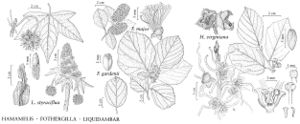Difference between revisions of "Hamamelidaceae"
FNA>Volume Importer |
FNA>Volume Importer |
||
| Line 13: | Line 13: | ||
}}<!-- | }}<!-- | ||
| − | --><span class="statement" id="st- | + | --><span class="statement" id="st-undefined" data-properties=""><b>Trees </b>or shrubs, deciduous; pubescence stellate or sometimes simple. <b>Dormant</b> buds naked or scaly. <b>Leaves</b> alternate, simple, petiolate; stipules early deciduous. <b>Leaf</b> blade unlobed or deeply (3-)5-7-lobed, pinnately or palmately veined. <b>Inflorescences</b> axillary or terminal, capitate or spicate to ± racemose, bracteate. <b>Flowers</b> bisexual or unisexual; perianth epigynous, 1-2-seriate, 4-5-merous, often reduced or absent, hypanthium present; calyx persistent, 4-5(-7)-lobed, or absent; petals distinct or absent; stamens 4-34; anthers basifixed, latrorse, 2-locular, longitudinally dehiscent by simple slit or by 1-2 vertical valves; pistil 1, 2-carpellate; ovary half-inferior, 2-locular; placentation axile; ovules 1(-2) in each locule and apical, or many, anatropous, pendent; styles and stigmas persistent, 2 each, erect or contorted and recurved. <b>Fruits</b> capsular, with leathery exocarp and bony endocarp, loculicidal and 2-seeded or septicidal with most of many seeds per locule aborted; 1-2 viable seeds per locule (Liquidambar). <b>Seeds</b> fusiform, bony, lustrous, hilum apical, light colored, or seeds winged, hilum lateral (Liquidambar).</span><!-- |
-->{{Treatment/Body | -->{{Treatment/Body | ||
| − | |distribution=Temperate to tropical regions;e North America;Mexico;Central America;e Asia;Africa (including Madagascar);Pacific Islands;and Australia | + | |distribution=Temperate to tropical regions;e North America;Mexico;Central America;e Asia;Africa (including Madagascar);Pacific Islands;and Australia. |
|discussion=<p>Genera ca. 31, species ca. 100 (3 genera, 5 species in the flora).</p> | |discussion=<p>Genera ca. 31, species ca. 100 (3 genera, 5 species in the flora).</p> | ||
|tables= | |tables= | ||
| Line 80: | Line 80: | ||
|family=Hamamelidaceae | |family=Hamamelidaceae | ||
|illustrator=John Myers | |illustrator=John Myers | ||
| − | |distribution=Temperate to tropical regions;e North America;Mexico;Central America;e Asia;Africa (including Madagascar);Pacific Islands;and Australia | + | |distribution=Temperate to tropical regions;e North America;Mexico;Central America;e Asia;Africa (including Madagascar);Pacific Islands;and Australia. |
|reference=bogle1970a;britton1905a;endress1987a;endress1989a;endress1989b;ernst1963a;godfrey1988a;goldblatt1977a | |reference=bogle1970a;britton1905a;endress1987a;endress1989a;endress1989b;ernst1963a;godfrey1988a;goldblatt1977a | ||
|publication title= | |publication title= | ||
|publication year= | |publication year= | ||
|special status= | |special status= | ||
| − | |source xml=https://jpend@bitbucket.org/aafc-mbb/fna- | + | |source xml=https://jpend@bitbucket.org/aafc-mbb/fna-data-curation.git/src/9216fc802291cd3df363fd52122300479582ede7/coarse_grained_fna_xml/V3/V3_664.xml |
| − | |||
| − | |||
| − | |||
| − | |||
| − | |||
| − | |||
| − | |||
| − | |||
| − | |||
| − | |||
| − | |||
| − | |||
| − | |||
| − | |||
| − | |||
| − | |||
| − | |||
| − | |||
| − | |||
| − | |||
| − | |||
| − | |||
| − | |||
| − | |||
| − | |||
| − | |||
| − | |||
| − | |||
| − | |||
| − | |||
| − | |||
| − | |||
| − | |||
| − | |||
| − | |||
| − | |||
| − | |||
| − | |||
| − | |||
| − | |||
| − | |||
| − | |||
| − | |||
| − | |||
| − | |||
| − | |||
| − | |||
| − | |||
| − | |||
| − | |||
| − | |||
| − | |||
| − | |||
| − | |||
| − | |||
| − | |||
| − | |||
| − | |||
| − | |||
| − | |||
| − | |||
| − | |||
| − | |||
}}<!-- | }}<!-- | ||
-->[[Category:Treatment]] | -->[[Category:Treatment]] | ||
Revision as of 13:46, 27 July 2019
Trees or shrubs, deciduous; pubescence stellate or sometimes simple. Dormant buds naked or scaly. Leaves alternate, simple, petiolate; stipules early deciduous. Leaf blade unlobed or deeply (3-)5-7-lobed, pinnately or palmately veined. Inflorescences axillary or terminal, capitate or spicate to ± racemose, bracteate. Flowers bisexual or unisexual; perianth epigynous, 1-2-seriate, 4-5-merous, often reduced or absent, hypanthium present; calyx persistent, 4-5(-7)-lobed, or absent; petals distinct or absent; stamens 4-34; anthers basifixed, latrorse, 2-locular, longitudinally dehiscent by simple slit or by 1-2 vertical valves; pistil 1, 2-carpellate; ovary half-inferior, 2-locular; placentation axile; ovules 1(-2) in each locule and apical, or many, anatropous, pendent; styles and stigmas persistent, 2 each, erect or contorted and recurved. Fruits capsular, with leathery exocarp and bony endocarp, loculicidal and 2-seeded or septicidal with most of many seeds per locule aborted; 1-2 viable seeds per locule (Liquidambar). Seeds fusiform, bony, lustrous, hilum apical, light colored, or seeds winged, hilum lateral (Liquidambar).
Distribution
Temperate to tropical regions, e North America, Mexico, Central America, e Asia, Africa (including Madagascar), Pacific Islands, and Australia.
Discussion
Genera ca. 31, species ca. 100 (3 genera, 5 species in the flora).
Selected References
Lower Taxa
Illustrations
Key
| 1 | Trees with simple hairs; leaf blade palmately (3-)5(-7)-lobed and - veined; flowers unisexual, terminal, the staminate in ± racemose heads, each head a clustered mass of numerous stamens, pistillate inflorescences many flowered; capsules septicidal, fused at base into long-pedunculate, globose, echinate heads; viable seeds winged, most seeds aborted. | Liquidambar |
| 1 | Shrubs or small trees with stellate pubescence; leaf blade unlobed, pinnately veined; flowers bisexual, in axillary, few-flowered clusters or in many-flowered, elongate spikes; capsules loculicidal, not fused into heads; viable seeds not winged. | > 2 |
| 2 | Inflorescences axillary, (1-)3(-5)-flowered clusters; calyx lobes 4, reflexed; petals 4, liguliform, yellow or reddish, deep red to orange; stamens 4, very short; staminodes 4; capsules solitary or 2-3 together. | Hamamelis |
| 2 | Inflorescences terminal, elongate, many-flowered spikes; calyx lobes 5-7(-9), erect; petals absent; stamens 12-34; filaments white, 4-17 mm; staminodes absent; capsules in groups of more than 3. | Fothergilla |
